The 14-month period from 31 January 2020 to 31 March 2021 was an excellent opportunity to assess whether a fund manager did a good job. That’s because January 2020 was the last monthly high before the pandemic hit markets and in March 2021, the ASX200 Accumulation Index returned to that level again. If you had invested in the ASX200 over this period, your return would have been just 0.7%.
This period features both the downturn and the upswing. Although it’s a short period, it has some of the characteristics of a complete market cycle. These are the periods when active managers should outperform and earn their fees.
So we checked this market high to market high to see how LIC managers performed. Did they add value?
How we did it
For this exercise, we wanted to measure the investment performance of the LIC manager, so we ignored changes in share prices and looked only at the change in underlying NTA plus dividends and distributions. This excludes the impact of other market forces, such as changes in discounts to NTA.
Generally, discounts and premiums magnify market ups and downs. For example, if you had taken the plunge and bought a LIC in March or April 2020, it’s almost certain that the current premium or discount is better than when you bought.
We looked at the change in pre-tax NTA plus dividends and distributions paid between January 2020 and March 2021. This penalises LIC managers slightly by including the impact of tax on realised gains. It also does not consider the effect of any corporate actions such as options and capital raisings. Even so, as you will see below, most managers still performed admirably after this handicap. For LITs, the trust structure means that, like ETFs and unlisted managed funds, there was no direct tax cost to handicap them.
We also highlight areas where active management has worked best, broken down by strategy. In many cases, particular LICs could have qualified in more than one strategy but we have placed LICs with the peer group we felt is the best fit.
Australian Large Cap Equities
For larger ASX stocks, where the ASX200 Accumulation Index delivered 0.7% for the period, we’ve used this as a benchmark. Results varied widely.
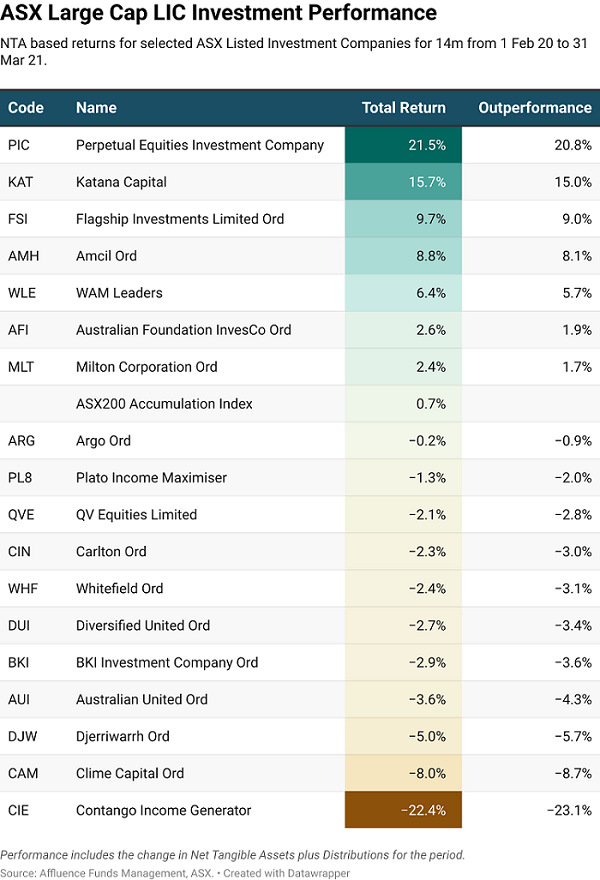
No doubt the star of the show was Perpetual. PIC delivered a total return of 21.5%. The result was helped by a small allocation to global equities and a resurgence in some of their favoured value stocks. Perpetual is genuinely differentiated from the index and it shone through. Other key outperformers were Katana Capital, helped by a decent allocation to resources, Flagship Investments, AMCIL and WAM Leaders.
What about the three largest LICs? AFIC and Milton added a small amount of value while Argo slightly underperformed.
At the wrong end of the table, we have AFIC stablemate Djerriwarrh, where some upside from the recovery may have been lost via their strategy to write call options. Clime Capital performed poorly while Contango Income Generator suffered as income stocks were hammered during COVID. This eventually resulted in the manager completely changing this LIC's strategy.
So, a mixed bag from large cap LICs with over 40% return difference between the best and worst performers.
Australian Small Cap Equities
Small caps are where the real opportunities exist for active managers, and most managers delivered in spades. The ASX Small Ords Accumulation Index did better than the ASX200 Accumulation Index over the period, with a 7.9% total return versus 0.7% for the ASX200.
Overall, 15 of the 21 small cap LICs, or around 70%, outperformed the Small Ords, many of them handsomely.
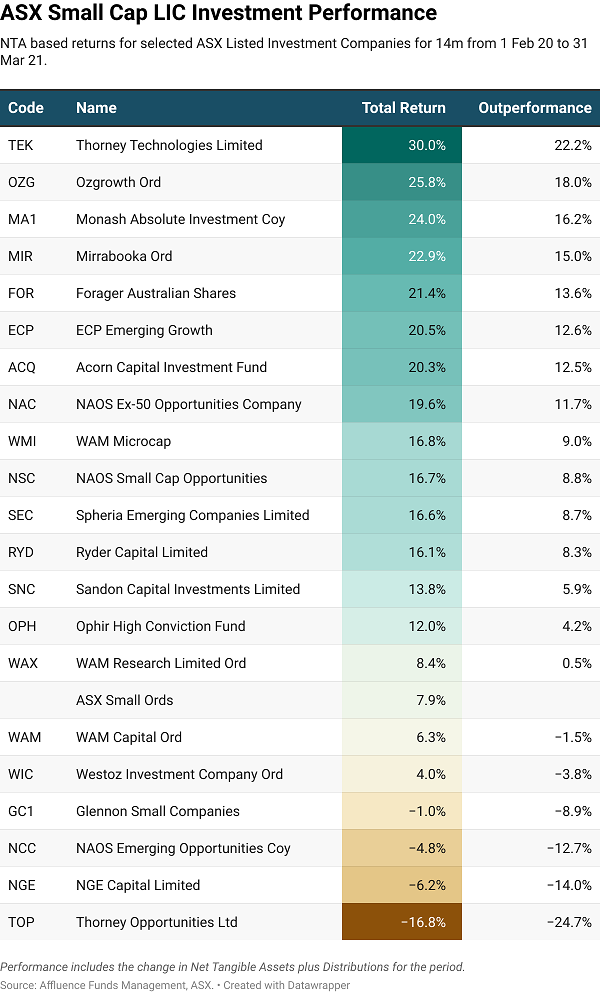
Unbelievably, both the top and bottom performers were managed by Thorney. This shows the stark difference that an investment style can make, even when run by the same management team. The technology focused TEK delivered a 30% return while old school value hunter TOP was the worst performer. TOP performance was made significantly worse by the management agreement with Thorney, which allows the performance fee hurdle to reset every year. This meant the $35 million loss suffered by shareholders in the 2020 financial year could be ignored. It resulted in a performance fee of $5.5 million in the second half of 2020 despite shareholders still being underwater.
Special mention must go to the team at Monash, who performed significantly better than most in the downturn and continued to add value during the recovery. In addition, they recently completed the transition of MA1 from an LIC to a listed managed fund, eliminating the considerable NTA discount and introducing a 6% per annum distribution target.
Global Equities
The MSCI All World Index returned 7.8% for the 14-month period, while US and many Asian indices fared even better.
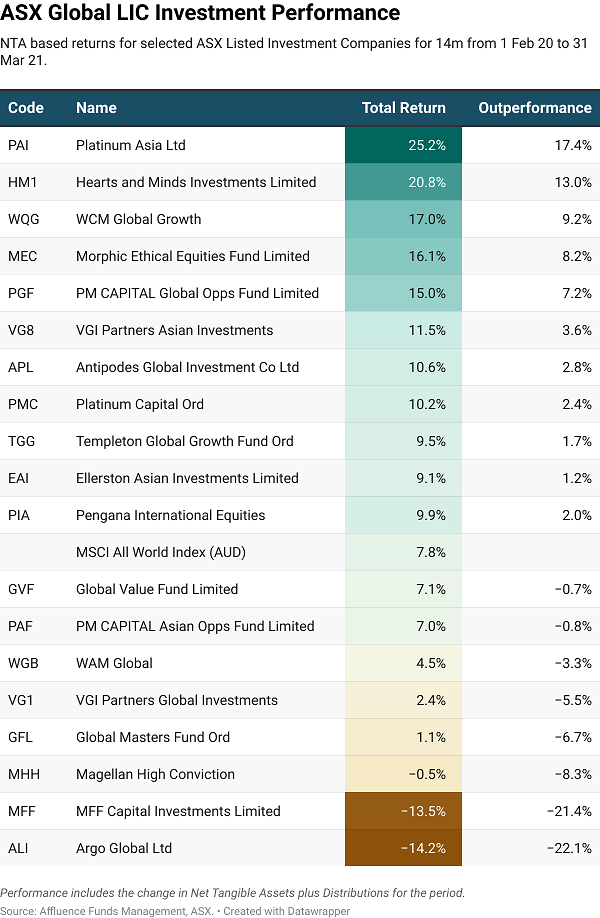
Platinum Asia and the flagship Platinum Capital did well as the value style slowly came good after a long period of underperformance. Other good performers included the successful Hearts and Minds Investments, WCM's US-focused global growth strategy, Morphic Ethical Equities and PM Capital, another value manager.
Two poor performers stand out. MFF Capital investments struggled after remaining overweight cash and missing a significant portion of the recovery. Argo Global is focused on listed infrastructure which has remained one of the areas most impacted by COVID.
Alternative Strategies
The alternative strategies group covers LICs that seek absolute returns, using tools such as shorting or carrying significant extra cash.
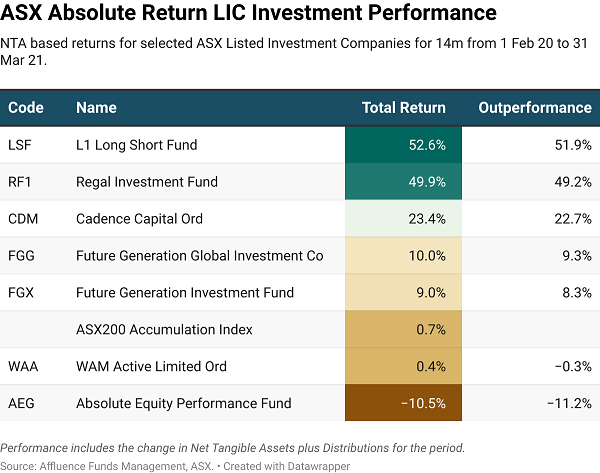
L1 Long Short Fund, despite being one of the most impacted initially on the downside, has recovered spectacularly well. They correctly recognised early in the recovery period that vaccines were likely to be highly effective and positioned the portfolio to benefit from value plays and the recovery trade. Regal Investment Fund, which incorporates a range of investment styles, also performed well. This was somewhat assisted by gearing embedded in some strategies. On the flipside, AEG, a geared market neutral fund, has struggled in an environment where value stocks have made a a comeback.
Alternative Assets
Our alternative assets group includes LICs investing in non-standard asset classes.
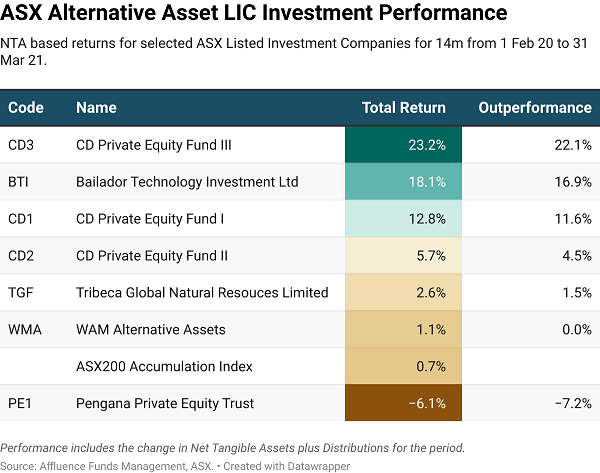
Outperformers included all three of the CD Private Equity Funds and Bailador's Technology focused private equity LIC.
The one disappointment was Pengana's Private Equity LIC. Despite weathering the downturn well, the recovery has been meagre for Pengana. It was not helped by the appreciation of the Australian dollar nor the additional capital raised by the manager.
Corporate and Real Estate Debt
Despite being a relative newcomer to the sector, debt focused LITs have primarily done their job. However, most of them traded at substantial discounts to their net asset value at some stage in 2020, requiring investors to hold their nerve to achieve the returns.
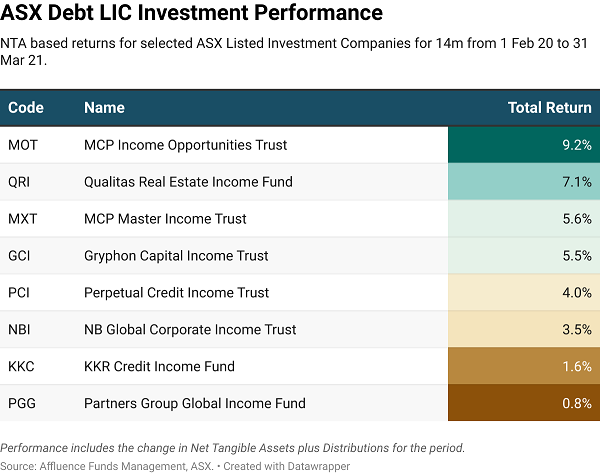
Two LITs from Metrics and one from Qualitas, both high-quality Australian managers, are at the top. All three delivered good results with no material loan losses. Of course, it helps that they hold private or unlisted debt, which is not marked to market like publicly-traded debt.
On the flipside, LITs from KKR and Partners Group generally have exposure to offshore publicly traded debt, which has not fared as well. We would also argue that this type of asset has a higher embedded risk. Indeed, these were also two of the most volatile LICs last year.
What have we learned?
From market peak to trough, and back to peak again, we've seen surprisingly diverse results from LIC managers, including many outstanding performers.
What lessons can we learn from this? Here are eight key takeaways, although these comments may apply to managed funds in general.
- The more a manager can deviate from a benchmark, the higher their chance to outperform. Of course, this also comes with a risk that they underperform. But if you choose talented managers with an excellent long-term track record, you've probably made a good start.
- Look carefully at what the manager is doing and question their competitive advantage. For example, it's harder to outperform in the biggest stocks. On the other hand, small cap managers and alternative strategies where the manager can have an information or skill advantage can deliver good results in choppy markets.
- Diversification is worthwhile. Picking one or two LICs might work, but it is better to have at least five and up to 10 for a diversified LIC portfolio.
- Investment style matters. Certain styles will outperform or underperform, potentially for long periods. Sometimes, that means two different LICs run by the same manager can have vastly different results.
- Bigger is not better. The performance of larger LICs was average overall. Most of the stellar results came from the medium and smaller sized LICs.
- Alternative strategies and alternative assets can be attractive diversifiers and perform relatively well when other investments struggle.
- Debt LITs did their job, eventually, with Australian assets and Australian managers delivering. Investors stomached volatility along the way.
- Finally, LICs can be an attractive addition to your portfolio. Increasing your allocation during times of market stress, when NTA discounts are higher and active managers can do their best work, can deliver outstanding investment results.
Greg Lander is a Portfolio Manager at Affluence Funds Management. This article is intended to provide general information only. It should not be construed as tax, legal or investment advice as it has been prepared without considering your objectives, financial situation or needs.